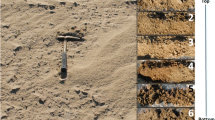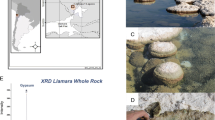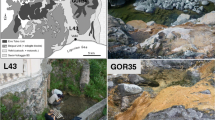Abstract
In this paper, we report the presence of sedimentary microbial ecosystems in wetlands of the Salar de Atacama. These laminated systems, which bind, trap and precipitate mineral include: microbial mats at Laguna Tebenquiche and Laguna La Brava, gypsum domes at Tebenquiche and carbonate microbialites at La Brava. Microbial diversity and key biogeochemical characteristics of both lakes (La Brava and Tebenquiche) and their various microbial ecosystems (non-lithifying mats, flat and domal microbialites) were determined. The composition and abundance of minerals ranged from trapped and bound halite in organic-rich non-lithifying mats to aragonite-dominated lithified flat microbialites and gypsum in lithified domal structures. Pyrosequencing of the V4 region of the 16s rDNA gene showed that Proteobacteria comprised a major phylum in all of the microbial ecosystems studied, with a marked lower abundance in the non-lithifying mats. A higher proportion of Bacteroidetes was present in Tebenquiche sediments compared to La Brava samples. The concentration of pigments, particularly that of Chlorophyll a, was higher in the Tebenquiche than in La Brava. Pigments typically associated with anoxygenic phototrophic bacteria were present in lower amounts. Organic-rich, non-lithifying microbial mats frequently formed snake-like, bulbous structures due to gas accumulation underneath the mat. We hypothesize that the lithified microbialites might have developed from these snake-like microbial mats following mineral precipitation in the surface layer, producing domes with endoevaporitic communities in Tebenquiche and carbonate platforms in La Brava. Whereas the potential role of microbes in carbonate platforms is well established, the contribution of endoevaporitic microbes to formation of gypsum domes needs further investigation.








Similar content being viewed by others
References
Airs RL, Keely BJ (2003) A high resolution study of the chlorophyll and bacteriochlorophyll pigment distributions in a calcite/gypsum microbial mat. Org Geochem 34:539–551
Ali-Bik MW, Metwally HI, Kamel MG, Wali AM (2011) Gypsum and dolomite biomineralization in endoevaporitic microbial niche, EMISAL, Fayium, Egypt. Environ Earth Sci 62:151–159
Alonso H, Risacher F (1996) Geoquímica del Salar de Atacama, parte 1: origen de los componentes y balance salino. Andean Geol 23:113–122
Arp G, Thiel V, Reimer A, Michaelis W, Reitner J (1999a) Biofilm exopolymers control microbialite formation at thermal springs discharging into the alkaline Pyramid Lake, Nevada, USA. Sediment Geol 126:159–176
Arp G, Reimer A, Reitner J (1999b) Calcification in cyanobacterial biofilms of alkaline salt lakes. Eur J Phycol 34:393–403
Babel M (2004) Models for evaporite, selenite and gypsum microbialite deposition in ancient saline basins. Acta Geol Pol 54:219–249
Baumgartner LK, Spear JR, Buckley DH, Pace NR, Reid RP, Dupraz C, Visscher PT (2009a) Microbial diversity in modern marine stromatolites, Highborne Cay, Bahamas. Environ Microbiol 11:2710–2719
Baumgartner LK, Dupraz C, Buckley DH, Spear JR, Pace NR, Visscher PT (2009b) Microbial species richness and metabolic activities in hypersaline microbial mats: insight into biosignature formation through lithification. Astrobiology 9:861–874
Bevacqua P (1992) Geomorfología del salar de Atacama y estratigrafía de su núcleo y delta, Segunda Región de Antofagasta, Chile. Memoria de Título (Inédito), Universidad Católica del Norte, Facultad de Ingeniería y Ciencias Geólogicas, 284 p. Antofagasta
Beveridge TJ (1981) Ultrastructure, chemistry, and function of the bacterial wall. Int Rev Cytol 72:229–317
Borrego CM, Garcia-Gil LJ (1994) Separation of bacteriochlorophyll homologues from green photosynthetic bacteria by reversed-phase HPLC. Photosynth Res 41:157–163
Bowman JP, Rea SM, McCammon SA, McMeekin TA (2000) Diversity and community structure within anoxic sediment from marine salinity meromictic lakes and a coastal meromictic marine basin, Vestfold Hills, Eastern Antarctica. Environ Microbiol 2:227–237
Braissant O, Cailleau G, Aragno M, Verrecchia EP (2004) Biologically induced mineralization in the tree Milicia excelsa (Moraceae): its causes and consequences to the environment. Geobiology 2:59–66
Braissant O, Decho AW, Dupraz C, Glunk C, Przekop KM, Visscher PT (2007) Exopolymeric substances of sulfate-reducing bacteria: interactions with calcium at alkaline pH and implication for formation of carbonate minerals. Geobiology 5:401–411
Braissant O, Decho AW, Przekop KM, Gallagher KL, Glunk C, Dupraz C, Visscher PT (2009) Characteristics and turnover of exopolymeric substances in a hypersaline microbial mat. FEMS Microbiol Ecol 67:293–307
Burne RV, Moore LS (1987) Microbialites: organosedimentary deposits of benthic microbial communities. Palaios 2:241–254
Cabrera S, Pizarro G (1994) Changes in chlorophyll a concentration, copepod abundance and UV and PAR penetration in the water column during the ozone depletion in Antarctic Lake Kitiesh, 1992. Adv Limnol/Ergeb Limnol 43:123–134
Canfield DE, Sorensen KB, Oren A (2004) Biogeochemistry of a gypsum-encrusted microbial ecosystem. Geobiology 2:133–150
Caporaso JG, Kuczynski J, Stombaugh J, Bittinger K, Bushman FD, Costello EK, Fierer N, Gonzalez Peña A, Goodrich AK, Gordon JI, Huttley GA, Kelley ST, Knights D, Koenig JE, Ley RE, Lozupone CA, McDonald D, Muegge BD, Pirrung M, Reeder J, Sevinsky JR, Turnbaugh PJ, Walters WA, Widmann J, Yatsunenko T, Zaneveld J, Knight R (2010) QIIME allows analysis of high-throughput community sequencing data. Nat Methods 7:335–336
Caumette P (1993) Ecology and physiology of phototrophic bacteria and sulfate-reducing bacteria in marine salterns. Experientia 49:473–481
Caumette P, Matheron R, Raymond N, Relexans J (1994) Microbial mats in the hypersaline ponds of Mediterranean salterns (Salins-de-Giraud, France). FEMS Microbiol Ecol 13:273–286
Cody AM, Cody RD (1989) Evidence for microbiological induction of [101] montmartre twinning of gypsum (CaSO4·2H2O). J Cryst Growth 98:721–730
Coman C, Drugă B, Hegedus A, Sicora C, Dragoş N (2013) Archaeal and bacterial diversity in two hot spring microbial mats from a geothermal region in Romania. Extremophiles 17:523–534
Costello EK, Halloy SR, Reed SC, Sowell P, Schmidt SK (2009) Fumarole-supported islands of biodiversity within a hyperarid, high-elevation landscape on Socompa Volcano, Puna de Atacama, Andes. Appl Environ Microbiol 75:735–747
Decho AW (2000) Exopolymer microdomains as a structuring agent for heterogeneity within microbial biofilms. In: Riding RE, Awramik SM (eds) Microbial sediments. Springer, Berlin, pp 9–15
Demergasso C, Chong G, Galleguillos P, Escudero L, Martinez-Alonso M, Steve I (2003) Microbial mats from the Llamara salt flat, northern Chile. Rev Chil Hist Nat 76:485–499
Demergasso C, Casamayor EO, Chong G, Galleguillos P, Escudero L, Pedròs-Aliò C (2004) Distribution of prokaryotic genetic diversity in athalassohaline lakes of the Atacama Desert, Northern Chile. FEMS Microbiol Ecol 48:57–69
Demergasso C, Escudero L, Casamayor EO, Chong G, Balague V, Pedros-Alió C (2008) Novelty and spatio-temporal heterogeneity in the bacterial diversity of hypersaline Lake Tebenquiche (Salar de Atacama). Extremophiles 12:491–504
Demergasso C, Dorador C, Meneses D, Blamey J, Cabrol N, Escudero L, Chong G (2010) Prokaryotic diversity pattern in high-altitude ecosystems of the Chilean Altiplano. J Geophys Res 115:G00D09
Dorador C (2007) Microbial communities in high altitude altiplanic wetlands in northern Chile: phytogeny, diversity and function. Doctoral dissertation, Christian-Albrechts-Universität, Kiel, Germany, p 166
Dorador C, Meneses D, Urtuvia V, Demergasso C, Vila I, Witzel KP, Imhoff JF (2009) Diversity of Bacteroidetes in high-altitude saline evaporitic basins in northern Chile. J Geophys Res 114:G00D05
Douglas S (2005) Mineralogical footprints of microbial life. Am J Sci 305:503–525
Dupraz C, Reid RP, Visscher PT (2011) Modern microbialites. In: Reitner J, Thiel V (eds) Encylopedia of geobiology. Springer, Berlin, pp 617–634
Dupraz C, Visscher PT (2005) Microbial lithification in marine stromatolites and hypersaline mats. Trends Microbiol 13:429–438
Dupraz C, Visscher PT, Baumgartner LK, Reid RP (2004) Microbe–mineral interactions: early carbonate precipitation in a hypersaline lake (Eleuthera Island, Bahamas). Sedimentology 51:745–765
Dupraz C, Reid RP, Braissant O, Decho AW, Norman RS, Visscher PT (2009) Processes of carbonate precipitation in modern microbial mats. Earth Sci Rev 96:141–162
Eaton AD, Clesceri LS, Rice EW, Greenberg AE, Franson MAH (2005) Standard methods for the examination of water and wastewater: Centennial edition. American Public Health Association, Washington DC, p 1368
Farías ME, Rascovan N, Toneatti DM, Albarracín VH, Flores MR, Poiré DG, Collavino MM, Aguilar OM, Vázquez MP, Polerecky L (2013) The discovery of stromatolites developing at 3570 m above sea level in a high-altitude volcanic lake Socompa, Argentinean Andes. PloS One 8:e53497
Flügel E (2004) Microfacies of carbonate rocks. Springer, Berlin
Gallagher KL, Braissant O, Kading TJ, Dupraz C, Visscher PT (2010) Phosphate-related artifacts in carbonate mineralization experiments. J Sediment Res 83:37–49
Gendrin A, Mangold N, Bibring J-P, Langevin Y, Gondet B, Poulet F, Bonello G, Quantin C, Mustard J, Arvidson R, LeMouélic S (2005) Sulfates in martian layered terrains: the OMEGA/Mars express view. Science 307:1587–1591
Gerdes G (2007) Structures left by modern microbial mats in their host sediments. In: Schieber J, Bose PK, Eriksson PG, Banerjee S, Sarkar S, Altermann W, Catuneau O (eds) Atlas of microbial mat features preserved within the clastic rock record. Elsevier, Amsterdam, pp 5–38
Gerdes G, Dunajtschik-Piewak K, Riege H, Taher AG, Krumbein WE, Reineck HE (1994) Structural diversity of biogenic carbonate particles in microbial mats. Sedimentology 41:1273–1294
Glunk C, Dupraz C, Braissant O, Gallagher KL, Verrecchia EP, Visscher PT (2011) Microbially mediated carbonate precipitation in a hypersaline lake, Big Pond (Eleuthera, Bahamas). Sedimentology 58:720–736
Green SJ, Blackford C, Bucki P, Jahnke LL, Prufert-Bebout L (2008) A salinity and sulfate manipulation of hypersaline microbial mats reveals stasis in the cyanobacterial community structure. ISME J 2:457–470
Hounslow A (1995) Water quality data: analysis and interpretation. CRC Press, New York
Humayoun SB, Bano N, Hollibaugh JT (2003) Depth distribution of microbial diversity in Mono Lake, a meromictic soda lake in California. Appl Environ Microb 69:1030–1042
Jahnert RJ, Collins LB (2011) Significance of subtidal microbial deposits in Shark Bay, Australia. Mar Geol 286:106–111
Jahnert RJ, Collins LB (2013) Controls on microbial activity and tidal flat evolution in Shark Bay, Western Australia. Sedimentology 60:1071–1099
Jiang H, Dong H, Yu B, Liu X, Li Y, Ji S, Zhang CL (2007) Microbial response to salinity change in Lake Chaka, a hypersaline lake on Tibetan plateau. Environ Microbiol 9:2603–2621
Kelly DP, Harrison AP (1989) Aerobic chemolithotrophic bacteria and associated organisms. In: Hensyl WR et al (ed) Bergey’s manual of systematic bacteriology, Vol 3. Williams and Wilkins, Baltimore, pp 1842–1858
Kirchman DL (2002) The ecology of Cytophaga–Flavobacteria in aquatic environments. FEMS Microbiol Ecol 39:91–100
Knoll AH, Golubic S (1992) Proterozoic and living cyanobacteria. In: Schidlowski M, Golubic S, Kimberley MM, McKirdy DM, Trudinger A (eds) Early organic evolution. Springer, Berlin, pp 450–462
Lara J, González LE, Ferrero M, Díaz GC, Pedrós-Alió C, Demergasso C (2012) Enrichment of arsenic transforming and resistant heterotrophic bacteria from sediments of two salt lakes in Northern Chile. Extremophiles 16:523–538
Ley RE, Harris JK, Wilcox J, Spear JR, Miller SR, Bebout BM, Maresca JA, Bryant DA, Sogin ML, Pace NR (2006) Unexpected diversity and complexity of the Guerrero Negro hypersaline microbial mat. Appl Environ Microb 72:3685–3695
López-López A, Yarza P, Richter M, Suárez-Suárez A, Antón J, Niemann H, Rosselló-Móra R (2010) Extremely halophilic microbial communities in anaerobic sediments from a solar saltern. Environ Microbiol Rep 2:258–271
Ludwig R (2004) Carbon cycling and calcification in hypersaline microbial mats. PhD dissertation, Biology/Chemistry, University of Bremen, Germany, p 157
Margheri MC, Tredici MR, Barsanti L, Balloni W (1987) The photosynthetic community of the Trapani saline lagoons: an alternative option for the exploitation of an extreme environment. Ann Microbiol 37:203–215
Mobberley JM, Ortega MC, Foster JS (2012) Comparative microbial diversity analyses of modern marine thrombolitic mats by barcoded pyrosequencing. Environ Microbiol 14:82–100
Myshrall KL, Mobberley JM, Green SJ, Visscher PT, Havemann SA, Reid RP, Foster JS (2010) Biogeochemical cycling and microbial diversity in the thrombolytic microbialites of Highborne Cay, Bahamas. Geobiology 8:337–354
Neilson JW, Quade J, Ortiz M, Nelson WM, Legatzki A, Tian F, LaComb M, Betancourt JL, Wing RA, Soderlund CA, Maier RM (2012) Life at the hyperarid margin: novel bacterial diversity in arid soils of the Atacama Desert, Chile. Extremophiles 16:553–566
Ollivier B, Caumette P, Garcia JL, Mah RA (1994) Anaerobic bacteria from hypersaline environments. Microbiol Rev 58:27–38
Oren A, Kuhl M, Karsten U (1995) An endoevaporitic microbial mat within a gypsum crust: zonation of phototrophs, photopigments, and light penetration. Mar Ecol Prog Ser 128:151–159
Oren A, Sørensen KB, Canfield DE, Teske AP, Ionescu D, Lipski A, Karlheinz A (2009) Microbial communities and processes within a hypersaline gypsum crust in a saltern evaporation pond (Eilat, Israel). Hydrobiology 626:15–26
Paterson DM (1994) Microbiological mediation of sediment structure and behaviour. In: Stal LJ, Caumette P (eds) Microbial mats. Springer, Berlin, pp 97–109
Pepe-Ranney C, Berelson WM, Corsetti FA, Treants M, Spear JR (2012) Cyanobacterial construction of hot spring siliceous stromatolites in Yellowstone National Park. Environ Microbiol 14:1182–1197
Peryt TM (1996) Sedimentology of Badenian (middle Miocene) gypsum in eastern Galicia, Podolia and Bukovina (West Ukraine). Sedimentology 43:571–588
Peryt TM, Peryt D, Jasionowski M, Poberezhskyy AV, Durakiewicz T (2004) Post-evaporitic restricted deposition in the Middle Miocene Chokrakian-Karaganian of East Crimea (Ukraine). Sediment Geol 170:21–36
Petrash DA, Lalonde SV, Pecoits E, Gingras MK, Konhauser KO (2010) Microbially-catalyzed cementation of modern gypsum-dominated thrombolites. Geochimica et Cosmochimica Acta 74:a811
Petrash DA, Gingras MK, Lalonde SV, Orange F, Pecoits E, Konhauser KO (2012) Dynamic controls on accretion and lithification of modern gypsum-dominated thrombolites, Los Roques, Venezuela. Sediment Geol 245–246:29–47
Reid RP, Visscher PT, Decho AW, Stolz JF, Bebout BM, Dupraz C, Macintyre IG, Paerl HW, Pinckney JL, Prufert-Bebout L, Steppe TF, DesMarais DJ (2000) The role of microbes in accretion, lamination and early lithification of modern marine stromatolites. Nature 406:989–992
Reid EA, Reid JS, Meier MM, Dunlap MR, Cliff SS, Broumas AA, Perry K, Maring H (2003) Characterization of African dust transported to puerto rico by individual particle and size segregated bulk analysis. J Geophys Res 108:16
Reitner J, Peckmann J, Blumenberg M, Michaelis W, Reimer A, Thiel V (2005) Concretionary methane-seep carbonates and associated microbial communities in Black Sea sediments. Palaeogeogr Palaeocl 227:18–30
Riding R (2011) Microbialites, stromatolites and thrombolites. In: Reitner J, Thiel V (eds) Encyclopedia of geology. Encyclopedia of earth science series. Springer, Heidelberg, pp 635–654
Risacher F, Alonso H, Salazar C (2003) The origin of brines and salts in Chilean salars: a hydrochemical review. Earth Sci Rev 63:249–293
Rothschild LJ, Giver LJ, White MR, Mancinelli RL (1994) Metabolic activity of microorganisms in evaporites. J Appl Phycol 30:431–438
Sahl JW, Pace NR, Spear JR (2008) Comparative molecular analysis of endoevaporitic microbial communities. Appl Environ Microb 74:6444–6446
Sanz Montero ME, Rodríguez Aranda JP (2008) Participación microbiana en la formación de magnesita dentro de un ambiente lacustre evaporítico: Mioceno de la Cuenca de Madrid. Macla 9:231–232
Sherwood JE, Stagnitti F, Kokkinn MJ, Williams WD (1991) Dissolved oxygen concentrations in hypersaline waters. Limnol Oceanogr 36:235–250
Spear JR, Ley RE, Berger AB, Pace NR (2003) Complexity in natural microbial ecosystems: the Guerrero Negro experience. Biol Bull 204:168–173
Stivaletta N, Barbieri R (2009) Endolithic microorganisms from spring mound evaporite deposits (southern Tunisia). J Arid Environ 73:33–39
Stivaletta N, López-García P, Boihem L, Millie DF, Barbieri R (2010) Biomarkers of endolithic communities within gypsum crusts (southern Tunisia). Geomicrobiol J 27:101–110
Stivaletta N, Barbieri R, Ceveninia F, López García P (2011) Physicochemical conditions and microbial diversity associated with the evaporite deposits in the Laguna de la Piedra (Salar de Atacama, Chile). Geomicrobiol J 28:83–95
Stoertz GE, Ericksen GE (1974) Geology of salars in northern Chile. US Geol Survey Professional Paper, vol 811, pp 65
Taher AG, Wahab SA, Philip G, Krumbein WE, Wali AM (1995) Evaporitic sedimentation and microbial mats in a salina system (Port Fouad, Egypt). Int J Salt Lake Res 4:95–116
Thompson JB, Ferris FG (1990) Cyanobacterial precipitation of gypsum, calcite, and magnesite from natural alkaline lake water. Geology 18:995–998
Usiglio J (1849) Analyse de I’eau de la Méditerranée sur les côtes de France. Ann Chemie 27:172–191
Vasconcelos C, McKenzie JA (1997) Microbial mediation of modern dolomite precipitation and diagenesis under anoxic conditions (Lagoa Vermelha, Rio de Janeiro, Brazil). J Sediment Res 67:378–390
Visscher PT, Stolz J (2005) Microbial mats as: populations, process and products reactors. Palaeogeogr Palaeocl 219:87–100
Visscher PT, Reid RP, Bebout BM, Hoeft SE, Macintyre IG, Thompson JA (1998) Formation of lithified micritic laminae in modern marine stromatolites (Bahamas): the role of sulfur cycling. Am Mineral 83:1482–1493
Visscher PT, Dupraz C, Braissant O, Gallagher KL, Glunk C, Casillas L, Reed RE (2010) Biogeochemistry of carbon cycling in hypersaline mats: linking the present to the past through biosignatures. In: Seckbach J, Oren A (eds) Microbial mats. Springer, Netherlands, pp 443–468
Vogel MB, Des Marais DJ, Turk KA, Parenteau MN, Jahnke LL, Kubo MD (2009) The role of biofilms in the sedimentology of actively forming gypsum deposits at Guerrero Negro, Mexico. Astrobiology 9:875–893
Vogel MB, Des Marais DJ, Parenteau MN, Jahnke LL, Turk KA, Kubo MD (2010) Biological influences on modern sulfates: textures and composition of gypsum deposits from Guerrero Negro, Baja California Sur, Mexico. Sediment Geol 223:265–280
Acknowledgments
This work was supported by Préstamo BID PICT 2010 No. 1788-Agencia Nacional de Promoción Científica y Tecnológica and Loreal-CONICET-UNESCO for Women in Science price. Flores, Kurth, Rasuk and Maldonado are recipients of a CONICET fellowship. We also want to thank Lic. Cecilia Genazzini and Mr. Pablo García of CONICET for their assistance in the XRD laboratory.
Author information
Authors and Affiliations
Corresponding author
Additional information
Communicated by A. Oren.
Rights and permissions
About this article
Cite this article
Farías, M.E., Contreras, M., Rasuk, M.C. et al. Characterization of bacterial diversity associated with microbial mats, gypsum evaporites and carbonate microbialites in thalassic wetlands: Tebenquiche and La Brava, Salar de Atacama, Chile. Extremophiles 18, 311–329 (2014). https://doi.org/10.1007/s00792-013-0617-6
Received:
Accepted:
Published:
Issue Date:
DOI: https://doi.org/10.1007/s00792-013-0617-6




